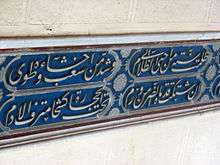Al-Busiri


al-Būsīrī (Abū 'Abdallāh Muhammad ibn Sa'īd ul-Būsīrī Ash Shadhili) (1211–1294) was a Sanhaji Berber[1][2]Sufi poet belonging to the Shadhiliyya order being direct disciple of Sheikh Abul Abbas al-Mursi ash Shadhili.
Biography
Al-Busiri was born Muhammad b. Saʿīd b. Ḥammād b. Muḥsin b. Abū Surūr b. Ḥibbān b. ʿAbdullah b. Mallak al-Sanhajī. Al-Maqrizi mentions that his family hailed from the Hammad citadel in Morocco and that they were of the Banu Habnun tribe. He lived in Egypt, where he wrote under the patronage of Ibn Hinna, the vizier. The most famous of these is the Qaṣīda al-Burda (Poem of the Mantle). It is entirely in praise of the last and true prophet of Allah, Muhammad, who cured the poet of paralysis by appearing to him in a dream and wrapping him in a mantle. The poem has had a unique history (cf. I. Goldziher in Revue de l'histoire des religions, vol. xxxi. pp. 304 ff.). Even in the poet's lifetime it was regarded as sacred. Up to the present time its verses are used as amulets; it is employed in the lamentations for the dead; it has been frequently edited and made the basis for other poems, and new poems have been made by interpolating four or six lines after each line of the original. It has been published with English translation by Faizullabhai (Bombay, 1893), with French translation by R. Basset (Paris, 1894), with German translation by C. A. Ralfs (Vienna, 1860), and in other languages elsewhere.[3]
Selected works
See also
- Al-Burda
- La Burda du désert, T. Ikbal, F. Tidjani, M. Vâlsan, Science sacrée, 2015
References
- For a long list of commentaries, etc., cf. C. Brockelmann's Gesch. der Arab. Litteratur (Weimar, 1898), vol. i. pp. 264–267
- ↑ His family came from Sijilmasa before settling in Beni Hama then Egypt. "الإمام شرف الدين محمد بن سعيد بن حماد الصنهاجي البوصيري". Retrieved 29 January 2014.
- ↑ "al-Busiri | Arabian poet". Retrieved 2016-07-21.
- ↑
 One or more of the preceding sentences incorporates text from a publication now in the public domain: Chisholm, Hugh, ed. (1911). "Būṣīrī". Encyclopædia Britannica. 4 (11th ed.). Cambridge University Press. p. 873.
One or more of the preceding sentences incorporates text from a publication now in the public domain: Chisholm, Hugh, ed. (1911). "Būṣīrī". Encyclopædia Britannica. 4 (11th ed.). Cambridge University Press. p. 873.